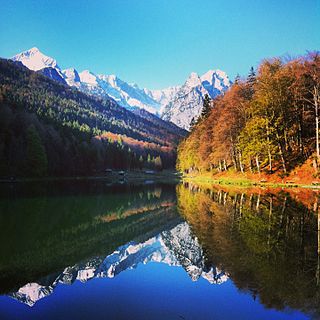
The 1936 Winter Olympics, officially known as the IV Olympic Winter Games and commonly known as Garmisch-Partenkirchen 1936, were a winter multi-sport event held from 6 to 16 February 1936 in the market town of Garmisch-Partenkirchen, Germany. The country also hosted the 1936 Summer Olympics, which were held in Berlin. It was the last year in which the Summer and Winter Games both took place in the same country.

Garmisch-Partenkirchen, nicknamed Ga-Pa, is an Alpine ski town in Bavaria, southern Germany. It is the seat of government of the district of Garmisch-Partenkirchen, in the Oberbayern region, which borders Austria. Nearby is Germany's highest mountain, Zugspitze, at 2,962 metres (9,718 ft) above sea level.
Jon Istad was a Norwegian biathlete and sport shooter.
The IBSF World Championships, part of the International Bobsleigh and Skeleton Federation, have taken place on an annual basis since 1930. Starting with 2002, championships of non-Winter Olympic years have not been held. A two-man event was included in 1931 with a combined championship occurring in 1947. Men's skeleton was introduced as a championship of its own in 1982 while women's bobsleigh and skeleton events were introduced in 2000. Both the women's bobsleigh and skeleton events were merged with the men's bobsleigh events at the 2004 championships. A mixed team event, consisting of one run each of men's skeleton, women's skeleton, 2-man bobsleigh, and 2-women bobsleigh debuted in 2007.
The FIBT World Championships 1953 took place in Garmisch-Partenkirchen, West Germany for the third time after previously hosting the four-man event of the championships in 1934 and 1938. The event was marred by the death of Switzerland's Felix Endrich who won the two-man event gold medal only to die in competition during the four-man event a week later.

Arnold "Noldi" Gartmann was a Swiss bobsledder who competed in the late 1930s. He won a gold medal in the four-man event at the 1936 Winter Olympics in Garmisch-Partenkirchen.
Felix Endrich was a Swiss bobsledder who competed in the late 1940s and early 1950s. Competing in two Winter Olympics, he won the gold medal along with brakeman Fritz Waller in the two-man event at the 1948 Winter Olympics in St. Moritz.
Fritz Schwarz was a German bobsledder who competed in the 1930s. He won two medals at the 1934 FIBT World Championships with a gold in the four-man and a silver in the two-man event.
Hermann von Valta was a German bobsledder who competed in the 1930s. He won two gold medals in the four-man event at the FIBT World Championships. Valta also competed at the 1936 Winter Olympics in Garmisch-Partenkirchen, finishing fifth in the two-man event and seventh in the four-man event.
David Looker was a British bobsledder who competed in the late 1930s. He won two gold medals in the four-man event at the FIBT World Championships, earning them in 1937 and 1938.
Joseph Winford Smith was an American bobsledder who competed in the 1950s. He won a gold medal in the four-man event at the 1953 FIBT World Championships in Garmisch-Partenkirchen.
Walter Haller was a West German bobsledder who competed in the late 1950s. He won a gold medal in the four-man event at the 1958 FIBT World Championships in Garmisch-Partenkirchen.

Fritz Karl Stöckli was a Swiss bobsledder and freestyle wrestler. As a wrestler he won silver medal in the light-heavyweight division at the 1946 European Championships and 1948 Summer Olympics; in 1946 he lost in the final to Bengt Fahlkvist, but avenged the loss in 1948.

Riessersee is a German lake located in southwest Garmisch-Partenkirchen. The lake itself hosted the speed skating events and 10 of the 37 ice hockey games for the 1936 Winter Olympics. Adjacent to the lake, the bobsleigh events took place.
Ragnar Tveiten is a former Norwegian biathlete. He participated on the Norwegian team that received a gold medal in 4 × 7.5 km relay in the 1966 Biathlon World Championships in Garmisch-Partenkirchen. He won a second gold medal in 4 × 7.5 km relay in the 1967 world championships in Altenberg. He received silver medals in 1969, 1970, 1971 and 1973.
Ivar Olaus Nordkild is a former Norwegian biathlete. He competed for Norway and won a gold medal in the 1965 Biathlon World Championships in Elverum in the team competition. He won a second gold medal in the men's relay in the 1966 world championships in Garmisch-Partenkirchen and a silver medal in the same event in 1971.
For the 1936 Winter Olympics in Garmisch-Partenkirchen, Germany, a total of six sports venues were used. Alpine skiing events took place for the first time and were held in three different locations. Riessersee held the speed skating and some of the ice hockey matches while the bobsleigh events took place south of the lake. The ski jump and its neighboring stadium played host to the cross-country skiing, Nordic combined, and ski jumping events. Even though figure skating and some of the ice hockey matches took place outdoors at the ice stadium, the ice itself was artificially refrigerated to prevent ice thawing.
For the 1956 Winter Olympics in Cortina d'Ampezzo, Italy, a total of eight sports venues were used. All of the venues used were new or rebuilt. To make use of television coverage for the first time in the Winter Olympics, the cross-country skiing stadium was constructed to allow the best coverage. Five of the venues used for these games would appear in the James Bond film For Your Eyes Only twenty-five years later.

At the 25th annual Four Hills Tournament, Jochen Danneberg became the third ski jumper after Helmut Recknagel and Bjørn Wirkola to defend his title. Crucial was a clear victory at the New Year's event in Garmisch-Partenkirchen. For the first time in ten years, there were four different winners at the single events.





